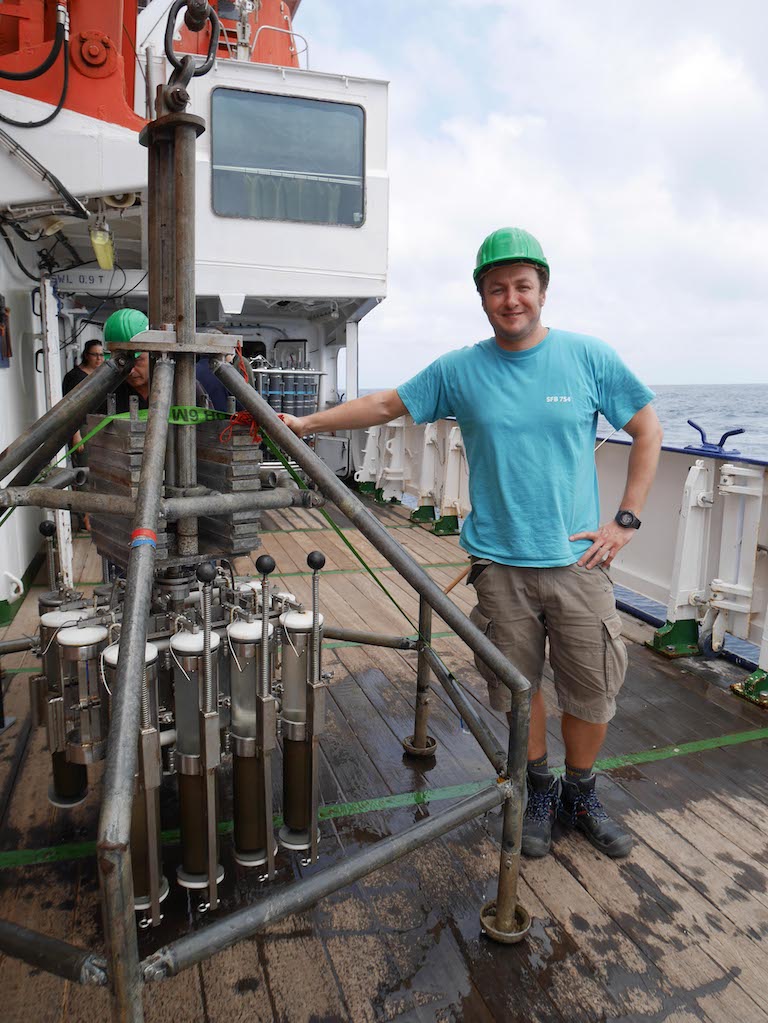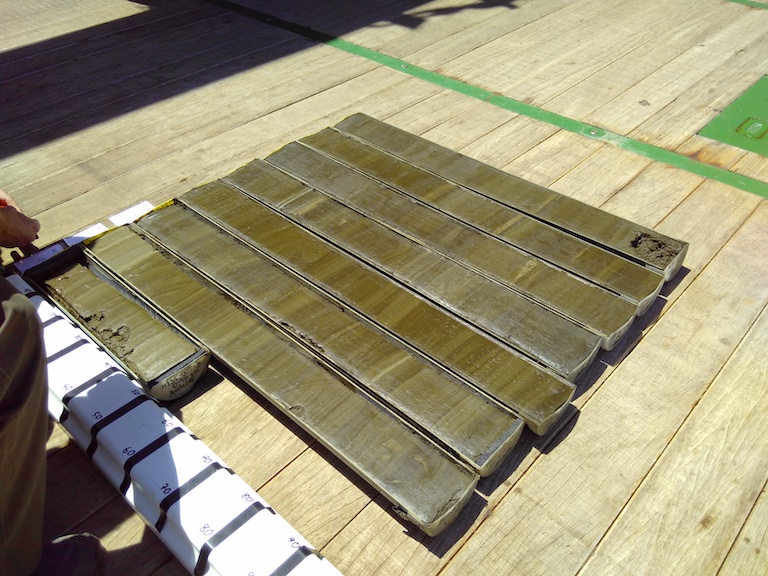- A new report using core samples taken from the seabed has determined that the Humboldt Current system off the coast of Peru was home to smaller fish during the last interglacial period, 130,000 years ago.
- The conditions back then — with little oxygen content in the ocean and temperatures about 2°C (3.6°F) warmer than the average temperature in the current Holocene epoch — mirror those that scientists have predicted for 2100.
- While many studies have argued that warmer water and lower oxygen lead to smaller fish, the added pressure of industrial fishing has made it difficult to determine the threat that climate change will pose on fisheries.
- The Humboldt Current system is one of the most productive fisheries in the world, contributing to more than 15% of the global annual fish catch, so significant changes to this system will threaten food security.
In 2008, a team of researchers boarded an expedition vessel and set sail for the anchovy-rich waters off the coast of Peru. They were searching for a place to extract a sediment sample that would unearth secrets about the ocean from 130,000 years ago, a time when the planet was experiencing its last interglacial period. About 130 kilometers (80 miles) north of Lima, the researchers found an ideal spot; they bore into the seabed and drew out a 20-meter (66-foot) core sample.
Over the next 13 years, researcher Renato Salvatteci and a team of colleagues worked to date the core and measure fish debris. They were trying to figure out what fish were living along the Humboldt Current system off the coast of Peru during that interglacial period, when the ocean contained little oxygen and was about 2° Celsius (3.6° Fahrenheit) warmer than the average temperature experienced in the current Holocene epoch — conditions that almost match what scientists project for 2100 as climate change rapidly transforms our modern world.
Today, the Humboldt Current contributes to more than 15% of the global annual fish catch, mainly due to its abundance of Peruvian anchoveta (Engraulis ringens), a species in the anchovy family. It’s also what global conservation authority the IUCN calls “the most heavily exploited single-species fishery in world history.”
Every centimeter of the sediment held an astonishing amount of information — about 90 years’ worth, said Salvatteci, a fisheries engineer at Kiel University in Germany. What they found embedded in the ancient sediment wasn’t anchoveta, but the vertebrae of “considerably smaller” fish, such as mesopelagic and goby-like fish, that were able to cope with the low oxygen levels in the water. They published their findings in Science on Jan. 6.

“There are many lines of evidence saying that a warm ocean with less oxygen will drive [the] shrinking of the fishes of the world,” Salvatteci told Mongabay in a video call. “But this is the first one [with] empirical evidence showing smaller fishes in the last interglacial, a period warmer than today. That’s why this paper is important.”
Salvatteci and his colleagues argue that the “environmental conditions and fish communities in the Humboldt Current are progressing toward those we reconstructed during the last interglacial,” posing a substantial threat to the global fish supply. Already, an increasing number of mesopelagic species — from the deeper, darker part of the ocean, known as the twilight zone, where less than 1% of sunlight penetrates — have been found in the region, such as Vinciguerria lucetia. At the same time, anchoveta biomass landings have decreased, according to the paper.
While conditions in the near future may be similar to the last interglacial period in terms of ocean temperature and oxygen levels, today there is the added pressure of industrial fishing, says co-author Arnaud Bertrand, a scientist at the French National Research Institute for Sustainable Development (IRD by its French acronym). This makes it difficult to determine the threat of climate change alone to the Humboldt Current system.
“Additional pressures from fishing could also be affecting fish size and communities, so it has been hard to tell if it is the warming climate that is affecting fish size or fishing pressure,” Bertrand told Mongabay in a joint interview with Salvatteci. “But during the interglacial period, this fishing pressure wasn’t present.”

In other words, this new study provides compelling evidence that the combination of warming waters and deoxygenation does indeed lead to smaller fish. But, of course, today’s fishing pressure puts additional pressure on the Humboldt Current ecosystem.
The Peruvian anchoveta fishery reported its highest annual catch, more than 13 million metric tons, in 1971, according to the NGO Oceana. Since then, catches have decreased, averaging 4 million to 8 million metric tons per year. This fishery is still one of the largest and most productive in the world, with a large majority being exported to China to be made into fishmeal, according to the FAO.
“Nobody knows when we are going to reach a tipping point, but … the peak of anchovy production in Peru has already passed,” Salvatteci said. “Maybe there will be years with huge anchovies in the ocean, but the trend is to lower anchovy biomass in the ocean in front of Peru, because of warming [and] because of the oxygenation. But we don’t know when that will happen.”
Boris Worm, a professor of marine conservation biology at Dalhousie University in Canada, who was not involved in this research, says the report is a “timely study that utilizes the past to understand our likely future in a warmer world.”
“Its findings support the prediction that warmer waters will hold smaller fish that may be better adapted to future conditions, but less likely to feed the world,” he told Mongabay in an email.
According to Worm, we need to anticipate climate related shifts in the ocean, not only in the Humboldt Current System, but just about everywhere, and manage fisheries appropriately.

“We cannot expect fish harvest to remain the same under climate change, and need to use our dwindling supply more cautiously, allowing for wider margins of error,” he said. “We also need to stop wasting fish, and use it more fully for human nutrition, rather than grinding it up for fishmeal (that is where >90% of Humboldt current anchovies end up).”
But is our future already written in the sediment, so to speak? The researchers call their results “concerning,” and urge fishery managers, global markets and other stakeholders to take measures to “cope with this threat” to the fish biomass in the Humboldt Current.
“There’s a phrase I love to say, that history doesn’t repeat itself, but it often rhymes — it’s Mark Twain who said that,” Salvatteci said. “So we may find some clues in the sediment and while we cannot say that this exact scenario will happen in the future … it’s very likely that we will not have a huge population or biomass of anchovies or other Engraulidae fishes in the future.”
Citation:
Salvatteci, R., Schneider, R. S., Galbraith, E., Field, D., Blanz, T., Bauersachs, T., … Bertrand, A. (2022). Smaller fish species in a warm and oxygen-poor Humboldt Current system. Science, 375(6576). doi:10.1126/science.abn2384
Banner image caption: Northern anchovy (Engraulis mordax). Image by Rhett A. Butler for Mongabay.
Correction (01/06/2022): A previous version of this article inaccurately stated that Renato Salvatteci participated in the expedition to retrieve the sediment samples for this study. However, he only used the core for his research, and the text was amended to reflect this insight.
Elizabeth Claire Alberts is a staff writer for Mongabay. Follow her on Twitter @ECAlberts.
Related listening from Mongabay’s podcast: What can seashells tell us about the health of the oceans? Listen here:
FEEDBACK: Use this form to send a message to the author of this post. If you want to post a public comment, you can do that at the bottom of the page.
